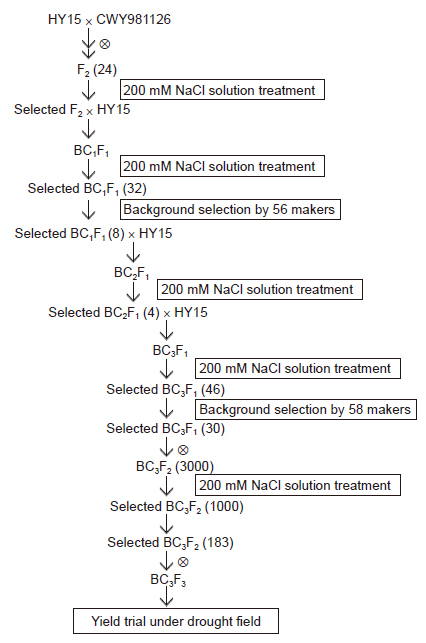All issues

Author:Dah-Jing Liao, Chieh-Wei Kuo, Su-Chen Kuo, I-Chun Lien, Yann-Rong Lin, and Yong-Pei Wu*
Abstract:
The salt tolerence of rice accession, CWY981126, was inherited from two complementary genes, revealed by the two F2 segregation populations of CWY981126 × ‘TNG82’ and CWY981126 × ‘TCS17’, for which the segregation ratio of 9 (salt sensitive) : 7 (salt tolerance) was detected in the F2 progenies treated with 200 mM NaCl at 5–6th leaf seedling stage. In the following, salt tolerant characteristic was transfered from CWY981126 to the drought tolerant variety, ‘HY15’, by marker-assisted backcrossing selection (MAB) for three generations. In the MAB breeding, CWY981126 and ‘HY15’ were used as the donor parent and recurrent parent, respectively. In each backcross genernation, progenies exhibiting salt tolerence with scale 3–5 were selected first after 200 mM NaCl treatment, and then were selected by marker-assisted selection for background selection. The genome recovery rates of BC1F1 and BC3F1 were 78.34% and 93.37%, respctivley, which were higher than theoretical recovery rates of traditional backcrosses. The BC3F3 generation was evaluated for drought tolerenace, indicating that 183 lines exhibited drought-tolerant characteristics. Consequently, these 183 linese were evaluated for yield potential in the field under water deficient condition. The yields were ranged from 2,280 kg ha-1 to 7,294 kg ha-1. A total of 6 out of 27 BC3F5 lines exhibited higher yields than the recurrent parent ‘HY 15’ after yield test. As a result, these new indica accessions possessing both drought and salt tolerance bred by MAB may be applied to cultivate in water-deficient and saline fields in the future in Taiwan and other countries.
Key words:Marker-assisted selection, Drought tolerance, Salt tolerance, Rice
Download:![]() PDF Links
PDF Links
- 1. Development of Tractor-Mounted Seedling Transplanter for Sweet Potato
- 2. Synergistic Effect of Additional Gas on the Toxicity of Phosphine to Sitophilus oryzae and Sitophilus zeamais (Coleoptera: Dryophthoridae)
- 3. Effects of Temperature and Solar Radiation on Growth Traits and Plant Elements in Purple Leafy Sweet Potato
 Submit your manuscript
Submit your manuscript
 Guide for authors
Guide for authors